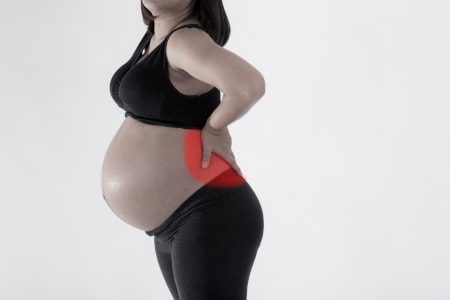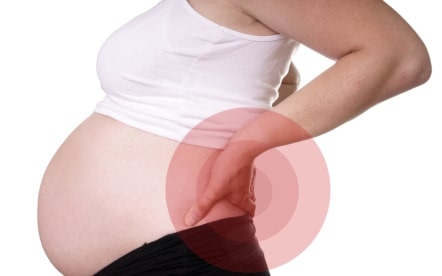Back pain during pregnancy
Back pain during pregnancy is common. Over 50% of pregnant women has problems with their back and pelvis. On the one hand, there is the ever increasing and heavier belly, putting extra strain on the body. On the other hand, the posture of a pregnant woman changes, resulting in more tensing of the back and pelvic muscles.
Causes of back pain during pregnancy
The lower back becomes hollower and that causes pressure and pain in the loin area. The shoulders are pointing more backwards, over-tensing the shoulder muscles and upper back muscles. An incorrect posture – that cannot be avoided – is also the result of weakened ligaments. Ligaments keep joints together, but during pregnancy, female hormones cause slackening of the ligaments. This makes the pelvis expand and causes slack. An ‘unstable’ pelvis gives the baby more space and makes labour easier. The disadvantage is that a pregnant woman can suffer more from pelvic instability.
What is pelvic instability?
The medical term for pelvic pain or pelvic instability is symphysiolysis. Symphysiolysis literally means a weakening (lysis) of the connection (symphysis) between the 2 pubic bones. This connection is made by ligaments, and to make labour easier, they become stretchier. The hormones of a pregnant women cause this weakening and as the birth approaches, this phenomenon increases.
Pelvic pain is the result of symphysiolysis and it causes an unstable pelvis. As the pregnancy progresses, the pelvis becomes more unstable and the problems increase. The pain is in general bearable but can cause serious functional limitations in some cases.
Some women have a naturally hollow back or have back problems already. They have greater risk of pelvic instability during pregnancy. The soft ligaments cause the pelvis to be too mobile. The back that is already hollow is becoming even hollower. Extra pressure is exerted on the lower vertebrae so that pregnant women have difficulty moving and walking.
With pelvic instability, many women have pain in the pubic bone, the groin and the lower back. Sometimes, pain radiates to the upper legs. The pain increases on movement but can also occur when turning in bed. The nagging pain is aggravating and requires extra rest.

Complaints when you have pelvic instability
The most occurring complaint is pain. It occurs on and around the pelvic bone and can even radiate to the groin. Pain in the lower back can also be felt, i.e. in the lower left and/or lower right of the back at the height of the two dimples. The buttocks and the back of the upper legs can also become more sensitive.
Pain deteriorates with tiredness, but also during certain movements – such as bending, turning and lifting – discomfort is experienced. Pain is worst in the coccyx during pelvic instability, because it experiences extra strain during jerky movements such as walking and cycling.
Start-up pain is also a typical characteristic: the pain emerges when a movement, such as straightening up, is started. Due to the pain, pregnant women tire more easily. Standing still for long periods and sauntering or being in the same posture for a long time, are definitely detrimental. Going shopping for an hour or so may result in having to take bed rest for the remainder of the day.
Pregnant and suffering from back pain? Read our 8 tips.
Women can deal with the back problems and pelvic instability that accompany pregnancy by treating their body in the correct way:
- Pain is a sign that the body is asking for balance between rest and activities. So, rest is very important.
- However, movement is necessary to keep muscles and body in shape. There are no specific requirements or prohibitions. Pregnant women can move, swim, cycle and do domestic chores. However, very demanding tasks must be avoided, and it is sensible to have a break after an activity.
- It is very important that pregnant women make sure their posture is correct by tensing the abdominal muscles and reducing the hollowness of the lower back. A therapist can give movement and posture advice to correct the posture and avoid as much as possible pressure on the pelvis during movement.
- Exercises to relax the back can reduce pain and provide relaxation. A simple technique – that can be done standing up, sitting or lying down – is the pelvic tilt: making the back alternatively hollow and round, which reduces the tension for a moment and can work wonders. Ask for advice from a therapist. A physiotherapist can reduce the pain by massage and light mobilisation techniques of the pelvis.

- A maternity pillow can help to adopt a good posture during sleep or rest.
- Moreover, a good slatted bed base and mattress are important. A mattress that is too soft, may cause or increase pain in the lower back during pregnancy, as these mattresses offer too little support of the pelvis and the lower back, so that the muscles in the waist experience extra tension. A good bed will not only relax the muscles and remove the pain, but also improve sleep. Dorsoo offers pregnant women extra support/recuperation during the night. The Dorsoo ACTIVE+ sleep system ensures good support of the pelvis and lower back, as with too little support, the back will be pushed in a round unnatural shape, in particular with the extra weight of the pregnancy. Not only will there be less pressure on the pelvis during sleep at night, but throughout the day, short rests on a good bed may work wonders.
- A supportive maternity belt can also be useful to support the belly and protect the back. However, a belt makes the muscles lazy, so it is best to wear it only when you experience pain or pressure.
- A pelvic belt – Also referred to as SI belt or sacroiliac belt – is a belt that supports the pelvis and pushes the pelvic bones together. The belt is a good aid and can certainly ease the pain.


